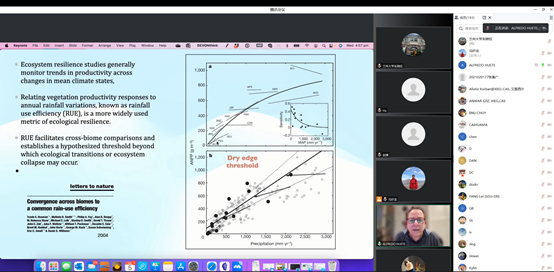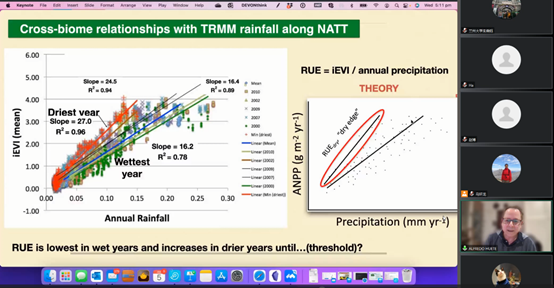On July 05, 2023, Professor Alfredo Huete from University of Technology Sydney, Australia gave an online lecture entitled "Ecological Resilience of Dryland Ecosystems: Progress & Issues" at the invitation of Ma Xuanlong, a researcher from the College of Earth and Environmental Sciences, Lanzhou University and the Key Laboratory of Western China's Environmental Systems, Ministry of Education. The lecture was hosted by Ma Xuanlong, a researcher from the College of Earth and Environmental Sciences of Lanzhou University, and nearly 1,000 faculty members, undergraduates and graduate students from Lanzhou University and related universities and research institutes attended the lecture.

Ecosystem resilience refers to the ability of an ecosystem to return to its normal state and function after an environmental disturbance such as an extreme climate event. In the context of increasing frequency and intensity of extreme weather events such as droughts and high temperatures caused by climate change and anthropogenic disturbances, research on ecosystem resilience based on satellite remote sensing can provide a scientific basis for defining the extent of fragile ecosystems on a macro scale and formulating corresponding conservation policies. This presentation will focus on the application of satellite remote sensing in ecosystem resilience, based on the recent work of the research group of the presenter, and review the latest progress, opportunities, and challenges in this field. Firstly, Professor Alfredo Huete introduced the definition of ecosystem resilience, the key characteristics and why it is important to maintain ecological resilience. Secondly, based on the work of his group in recent years, he presented the question "How does vegetation adapt to changing environments?" This question, citing the collapse of extensive Amazonian forests and the shift to savannas due to global warming-induced drought, raises the question of whether contemporary climate change and extreme events can be used as a unique opportunity to study ecological sensitivity and productivity responses. Using the large potential of in situ data and satellite observation datasets for climate variability and vegetation, starting with the millennium drought in Australia, the research team used climate experiments to conclude that "big dry" and "big wet" may lead to anomalies in terrestrial water storage and carbon sinks, and that rainfall variability may increase the likelihood of severe droughts under future climate scenarios. Then, the relationship between productivity and rainfall in arid regions is discussed, and the concept of Rain Use Effectivity (RUE) is proposed. By comparing the consistency of EVI and annual rainfall and assessing the spatial variability of RUE, it is concluded that RUE is lowest in wet years and increases in dry years until a threshold value is reached. Also, multi-species or species invasion may lead to a temporary increase of ANPP.

Finally, regarding the importance of satellite remote sensing data for the study of vegetation dynamics, Professor Alfredo pointed out that satellite information is only part of a larger scale and needs to be integrated with other information, such as ground data, to fully understand the intrinsic characteristics of vegetation communities and contribute to the understanding of vegetation ecophysiological mechanisms of ecosystem resilience in a changing climate. Professor Alfredo Huete's rich research results and insightful explanation have given students and faculty a deep understanding of ecological sensitivity and the importance of its response to climate variability. Only by understanding the current mechanisms of climate change response to ecological resilience and the important biological feedbacks can we improve the predictive models of climate change on the Earth's ecosystems, biodiversity, food security, and other benefits to humans in the future.
After the presentation, Professor Alfredo Huete had a full discussion with several students and faculty members on the relationship between ecosystem resilience and climate variability and other related academic issues, and gave an outlook on the possible development of using EO (Earth Observation) data in ecological resilience research from various perspectives. The presentation enriched the students' understanding of dryland ecological resilience research and broadened their horizons.